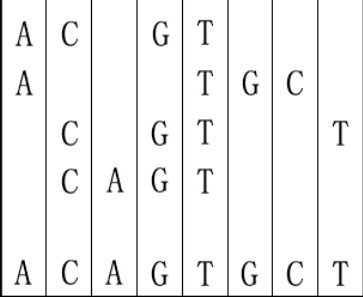HDU1560 DNA sequence —— IDA*算法
题目链接:http://acm.hdu.edu.cn/showproblem.php?pid=1560
DNA sequence
Time Limit: 15000/5000 MS (Java/Others) Memory Limit: 32768/32768 K (Java/Others)
Total Submission(s): 2999 Accepted Submission(s): 1462
sequences is one of the basic problems in modern computational molecular biology. But this problem is a little different. Given several DNA sequences, you are asked to make a shortest sequence from them so that each of the given sequence is the subsequence
of it.
For example, given "ACGT","ATGC","CGTT" and "CAGT", you can make a sequence in the following way. It is the shortest but may be not the only one.

sequence is between 1 and 5.
4
ACGT
ATGC
CGTT
CAGT
题解:
一开始以为是直接用回溯的方法,结果TLE。看了题解是用IDA*(迭代加深搜),其实自己不太了解迭代加深搜为什么比较快,而且什么时候用合适?下面是自己对迭代加深搜的一些浅薄的了解:
1.首先迭代加深搜适合用在:求最少步数(带有BFS的特点)并且不太容易估计搜索深度的问题上,同时兼有了BFS求最少步数和DFS易写、无需多开数组的特点。
2.相对于赤裸裸的回溯,迭代加深搜由于限制了搜索深度,所以也能适当地剪枝。
3.我编不下去了……
代码一:
#include <iostream>
#include <cstdio>
#include <cstring>
#include <cmath>
#include <algorithm>
#include <vector>
#include <queue>
#include <stack>
#include <map>
#include <string>
#include <set>
#define ms(a,b) memset((a),(b),sizeof((a)))
using namespace std;
typedef long long LL;
const int INF = 2e9;
const LL LNF = 9e18;
const int MOD = 1e9+;
const int MAXN = +; int n;
char dna[MAXN][MAXN];
int len[MAXN], pos[MAXN];
char s[] = {'A', 'G', 'C', 'T'}; bool dfs(int k, int limit) //k为放了几个, k+1才为当前要放的
{
int maxx = , cnt = ; //maxx为最长剩余的dna片段, cnt为剩余的片段之和(核苷酸链?好怀念啊)
for(int i = ; i<n; i++)
{
cnt += len[i]-pos[i];
maxx = max(maxx, len[i]-pos[i]);
}
if(cnt==) return true; //如果片段都放完,则已得到答案
if(cnt<=limit-k) return true; //剪枝:片段之和小于等于剩余能放数量,肯定能够得到答案
if(maxx>limit-k) return false; //剪枝:最小的估计值都大于剩余能放数量,肯定不能得到答案 int tmp[MAXN];
for(int i = ; i<; i++)
{
memcpy(tmp, pos, sizeof(tmp));
bool flag = false;
for(int j = ; j<n; j++)
if(dna[j][pos[j]]==s[i])
pos[j]++, flag = true; //k+1<=limit:在限制范围内
if(k+<=limit && flag && dfs(k+, limit) )
return true;
memcpy(pos, tmp, sizeof(pos));
}
return false;
} int main()
{
int T;
scanf("%d",&T);
while(T--)
{
scanf("%d",&n);
int limit = ;
for(int i = ; i<n; i++)
{
scanf("%s",dna[i]);
len[i] = strlen(dna[i]);
limit = max(limit, len[i]);
} ms(pos, );
while(!dfs(, limit))
limit++;
printf("%d\n", limit);
}
}
代码二:
#include <iostream>
#include <cstdio>
#include <cstring>
#include <cmath>
#include <algorithm>
#include <vector>
#include <queue>
#include <stack>
#include <map>
#include <string>
#include <set>
#define ms(a,b) memset((a),(b),sizeof((a)))
using namespace std;
typedef long long LL;
const int INF = 2e9;
const LL LNF = 9e18;
const int MOD = 1e9+;
const int MAXN = +; int n;
char dna[MAXN][MAXN];
int len[MAXN], pos[MAXN];
char s[] = {'A', 'G', 'C', 'T'}; bool dfs(int k, int limit) //k为放了几个, k+1才为当前要放的
{
if(k>limit) return false; int maxx = , cnt = ; //maxx为最长剩余的dna片段, cnt为剩余的片段之和(核苷酸链?好怀念啊)
for(int i = ; i<n; i++)
{
cnt += len[i]-pos[i];
maxx = max(maxx, len[i]-pos[i]);
}
if(cnt==) return true; //如果片段都放完,则已得到答案
if(cnt<=limit-k) return true; //剪枝:片段之和小于等于剩余能放数量,肯定能够得到答案
if(maxx>limit-k) return false; //剪枝:最小的估计值都大于剩余能放数量,肯定不能得到答案 int tmp[MAXN];
for(int i = ; i<; i++)
{
memcpy(tmp, pos, sizeof(tmp));
bool flag = false;
for(int j = ; j<n; j++)
if(dna[j][pos[j]]==s[i])
pos[j]++, flag = true; if(flag && dfs(k+, limit) )
return true;
memcpy(pos, tmp, sizeof(pos));
}
return false;
} int main()
{
int T;
scanf("%d",&T);
while(T--)
{
scanf("%d",&n);
int limit = ;
for(int i = ; i<n; i++)
{
scanf("%s",dna[i]);
len[i] = strlen(dna[i]);
limit = max(limit, len[i]);
} ms(pos, );
while(!dfs(, limit))
limit++;
printf("%d\n", limit);
}
}
HDU1560 DNA sequence —— IDA*算法的更多相关文章
- HDU1560 DNA sequence IDA* + 强力剪枝 [kuangbin带你飞]专题二
题意:给定一些DNA序列,求一个最短序列能够包含所有序列. 思路:记录第i个序列已经被匹配的长度p[i],以及第i序列的原始长度len[i].则有两个剪枝: 剪枝1:直接取最长待匹配长度.1900ms ...
- HDU1560 DNA sequence(IDA*)题解
DNA sequence Time Limit: 15000/5000 MS (Java/Others) Memory Limit: 32768/32768 K (Java/Others) To ...
- Hdu1560 DNA sequence(IDA*) 2017-01-20 18:53 50人阅读 评论(0) 收藏
DNA sequence Time Limit : 15000/5000ms (Java/Other) Memory Limit : 32768/32768K (Java/Other) Total ...
- HDU1560 DNA sequence
题目: The twenty-first century is a biology-technology developing century. We know that a gene is made ...
- HDU 1560 DNA sequence (IDA* 迭代加深 搜索)
题目地址:http://acm.hdu.edu.cn/showproblem.php?pid=1560 BFS题解:http://www.cnblogs.com/crazyapple/p/321810 ...
- HDU 1560 DNA sequence(IDA*)
题目链接:http://acm.hdu.edu.cn/showproblem.php?pid=1560 题目大意:给出n个字符串,让你找一个字符串使得这n个字符串都是它的子串,求最小长度. 解题思路: ...
- DNA sequence HDU - 1560(IDA*,迭代加深搜索)
题目大意:有n个DNA序列,构造一个新的序列,使得这n个DNA序列都是它的子序列,然后输出最小长度. 题解:第一次接触IDA*算法,感觉~~好暴力!!思路:维护一个数组pos[i],表示第i个串该匹配 ...
- 【学时总结】 ◆学时·II◆ IDA*算法
[学时·II] IDA*算法 ■基本策略■ 如果状态数量太多了,优先队列也难以承受:不妨再回头看DFS-- A*算法是BFS的升级,那么IDA*算法是对A*算法的再优化,同时也是对迭代加深搜索(IDF ...
- DNA sequence(映射+BFS)
Problem Description The twenty-first century is a biology-technology developing century. We know tha ...
随机推荐
- LVM 类型的 Storage Pool
LVM 类型的 Storage Pool 不仅一个文件可以分配给客户机作为虚拟磁盘,宿主机上 VG 中的 LV 也可以作为虚拟磁盘分配给虚拟机使用. 不过,LV 由于没有磁盘的 MBR 引导记录,不能 ...
- GIL锁、死锁、递归锁、定时器
GIL (Global Interpreter Lock) 锁 '''定义:In CPython, the global interpreter lock, or GIL, is a mutex th ...
- 洛谷 P1503鬼子进村
题目背景 小卡正在新家的客厅中看电视.电视里正在播放放了千八百次依旧重播的<亮剑>,剧中李云龙带领的独立团在一个县城遇到了一个鬼子小队,于是独立团与鬼子展开游击战. 题目描述 描述 县城里 ...
- CodeWar---将字符串转换为驼峰命名
Convert string to camel case 将字符串转换为驼峰命名 自己的解法 将不是字母和数字的字符用.取代,再根据点划分数组.将下标不为0的数组首字符大写,剩下全部小写 static ...
- WebGIS开发之用openlayers加载离线百度地图
因为项目需要,只有内网环境,没有外网环境,所以需要下载地图瓦片. 一.下载瓦片地图 这个可以自行在网上找一些地图瓦片下载器,下好的瓦片地图是分级的.大概如图这种类型. 二.在地图上显示标记 首先使用o ...
- 关于one-hot encoding思考
Many learning algorithms either learn a single weight per feature, or they use distances between sam ...
- SolidEdge 工程图中如何绘制中断视图
右击长条形的视图,点击新增断裂线,然后绘制两个断点 点击完成之后效果如下图所示 如果要修改断裂视图的样式,则选中这个视图,在左键单击,然后点击这个按钮取消显示断裂视图 然后左键单击断裂视图 ...
- sort-list——链表、快慢指针找中间、归并排序
Sort a linked list in O(n log n) time using constant space complexity. 链表,快慢指针找中点,归并排序. 注意判断条件fast-& ...
- LOCAL_CFLAGS参数说明
1.-Wall 是打开警告开关 2.-O 代表默认优化,可选:-O0不优化,-O1低级优化,-O2中级优化,-O3高级优化,-Os代码空间优化 3.-g 是生成调试信息,生成的可执行文件具有和源代码关 ...
- push代码到github时,每次都要输入用户名和密码的问题
问题原由 我在Github上 建立了一个小项目TauStreamingServer,可是在每次push代码 的时候,都要求输入用户名和密码,很是麻烦. 如何才能避免每次都输入用户名和密码呢? 解决办法 ...
